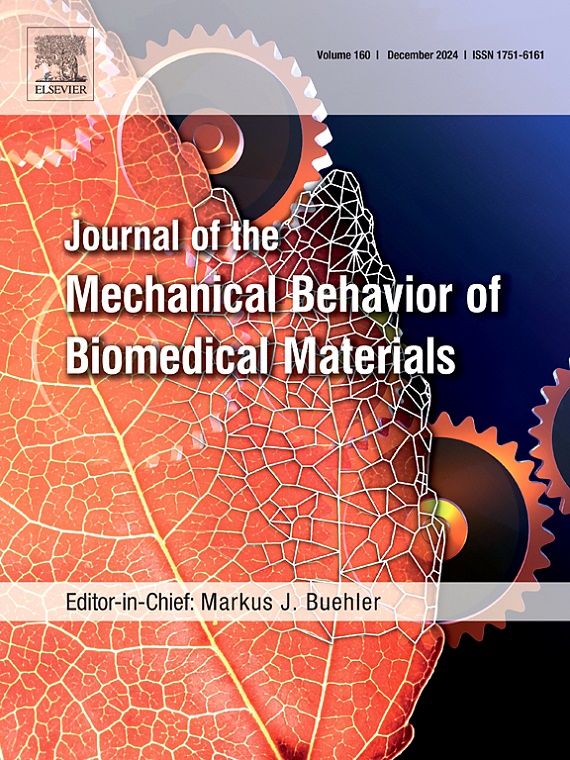Dynamics of soft connective tissues and implications for synthetic biomaterials: interfacing the frequency and time domains
IF 3.5
2区 医学
Q2 ENGINEERING, BIOMEDICAL
Journal of the Mechanical Behavior of Biomedical Materials
Pub Date : 2025-07-22
DOI:10.1016/j.jmbbm.2025.107143
引用次数: 0
Abstract
Soft connective tissues found in the body have a mechanical role to support and transfer load, provide protection, to cells and organs across all physiological systems of the body. They typically function within dynamic loading environments. This review explores the characterisation of soft connective tissues under cyclic loading, with implications for replacement biomaterials. The aim is to identify how characterisation of material properties within a frequency-domain can be effectively exploited in a time-domain for engineering applications. Material properties, such as dynamic viscoelasticity, are reviewed for a range of natural soft connective tissues and selected synthetic replacement materials. A case-study for brain tissue is used to evidence how the frequency-time domain gap can be bridged. Synthetic biomaterials evaluated include long-term implantable polycarbon urethanes, as they are used widely in medical devices. A final case-study outlines how long-term implantable biomaterials, within a medical device, can be evaluated across time and frequency domains which can result in predictive tools for performance. In summary, soft connective tissues support and transfer loads, across all physiological systems of the body, their frequency-domain characterisation is beneficial as it enables clearer links to typical loading experienced within the body. Transferring the frequency-domain characterisation to the time-domain has engineering applications, with the potential for effective healthcare technologies including via numerical analysis of tissue mechanics such as finite element analysis.

软结缔组织动力学及其对合成生物材料的影响:频率和时间域的连接
软结缔组织存在于身体中,具有支持和转移负荷的机械作用,为身体所有生理系统的细胞和器官提供保护。它们通常在动态加载环境中工作。这篇综述探讨了循环载荷下软结缔组织的特征,以及对替代生物材料的影响。目的是确定如何在频域内有效地利用材料特性在时域内进行工程应用。材料性能,如动态粘弹性,回顾了一系列天然软结缔组织和选定的合成替代材料。一个脑组织的案例研究被用来证明如何可以弥合频域的差距。评估的合成生物材料包括长期可植入的聚碳聚氨酯,因为它们广泛用于医疗设备。最后一个案例研究概述了如何跨时间和频域评估医疗设备内的长期植入式生物材料,从而产生性能预测工具。总之,软结缔组织在身体的所有生理系统中支持和转移负荷,它们的频域特征是有益的,因为它可以更清楚地连接到体内经历的典型负荷。将频域特征转移到时域具有工程应用,具有有效医疗保健技术的潜力,包括通过组织力学的数值分析,如有限元分析。
本文章由计算机程序翻译,如有差异,请以英文原文为准。
求助全文
约1分钟内获得全文
求助全文
来源期刊

Journal of the Mechanical Behavior of Biomedical Materials
工程技术-材料科学:生物材料
CiteScore
7.20
自引率
7.70%
发文量
505
审稿时长
46 days
期刊介绍:
The Journal of the Mechanical Behavior of Biomedical Materials is concerned with the mechanical deformation, damage and failure under applied forces, of biological material (at the tissue, cellular and molecular levels) and of biomaterials, i.e. those materials which are designed to mimic or replace biological materials.
The primary focus of the journal is the synthesis of materials science, biology, and medical and dental science. Reports of fundamental scientific investigations are welcome, as are articles concerned with the practical application of materials in medical devices. Both experimental and theoretical work is of interest; theoretical papers will normally include comparison of predictions with experimental data, though we recognize that this may not always be appropriate. The journal also publishes technical notes concerned with emerging experimental or theoretical techniques, letters to the editor and, by invitation, review articles and papers describing existing techniques for the benefit of an interdisciplinary readership.
 求助内容:
求助内容: 应助结果提醒方式:
应助结果提醒方式:


